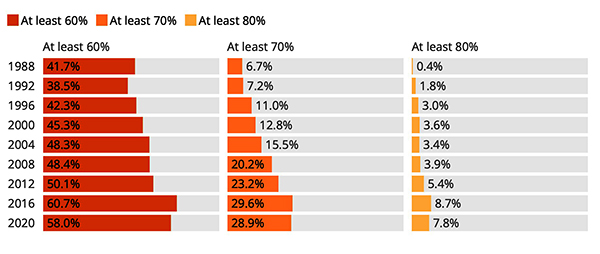

Back in February, Rep. Marjorie Taylor Greene (R-GA) called for a "national divorce"—basically, Civil War, Part II. She was born in Georgia and went to high school and college in the state, so she ought to know that when Gen. William Tecumseh Sherman visited the Peach State in 1864, he made a bit of a mess there. But maybe they don't talk about that in Georgia anymore or maybe she wasn't paying attention in class when the subject came up. Still, she was born in Milledgeville, GA, where Sherman and 30,000 of his best friends visited in 1864 on their way to Savannah. We don't know if there is a monument at St. Stephen's Church, where Sherman had molasses and sorghum poured down the pipes of the church organ before he left town. The church's website certainly doesn't mention it.
In any event, Amy Walter of the Cook Political Report notes that we may not be divorced yet, but we are already working on a trial separation. Look at this chart:

In 1988, about 42% of Americans lived in a county that went for one candidate or the other by at least 60%. This means that 58% of Americans lived in a more-or-less swing county and that they regularly encountered people from the opposing party. By 2016, it was completely reversed. Then, 61% of Americans lived in a deep red or deep blue county, an increase of almost 50% over 1988. The trial separation was already under way.
The second column of the chart shows the percentage of Americans living in a 70% county, a really deep red or blue county. It was about 7% in 1988 and jumped to almost 30% by 2016. The third column sets the bar even higher. In 1988, counties that went for either candidate by 80% were practically nonexistent (0.4%), but by 2016 that had grown to almost 9%. In 2020, there was a tad less separation, but that is probably just statistical noise. The long-term trend is very clear.
At the state level, we see the same thing. In the past four elections, 80% of the states voted the same way across all four. That is a greater polarization than even during FDR's four elections, where two-thirds of the states voted for or against him each time.
What happened? For one thing, now everything is polarized and you are expected to accept the entire package. If you own an AR-15, you are expected to oppose abortions and vaccinations, even though these things really aren't related. Also, 30 years ago, there were liberal Republicans and conservative Democrats, including senators. Now there are no liberal Republican senators and only one conservative Democratic senator, Joe Manchin (D-WV). Another factor is cable television, which whips people into a frenzy, and social media, which reinforces the frenzy. When was the last time you met someone who said: "I don't care about party labels, I always vote for the best candidate"?
This geographic sorting, except for about 5-10 states, means that we are already living apart, even if the separation hasn't been formalized. People meet only like-minded people and state legislatures pass laws that fit their states. The county data are more important than the state data, however, because red states do have blue cities and blue states do have red counties. But the people one meets on a daily basis are usually from the same county, not some distant county, and the counties are getting more homogeneous all the time.
The trial separation is only going to get worse. A new survey shows that a quarter of college applicants decided against colleges that were otherwise all right based on the state's politics. Most students attend college in their own state, so this will mostly affect major research universities that draw students from all over the country (and all over the world). That means even fewer conservative students at Stanford (California) and fewer liberal students at Rice (Texas). If liberal students go to college in blue states and conservative students go to college in red states, that simply reinforces the existing trend of geographic separation. (V)